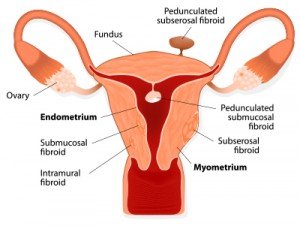Fibroid Embolization vs. Hysterectomy Surgery
- Details
- by: Leah Johnson
Most women who have uterine fibroids experience no symptoms. But if you’re one of the unlucky women whose fibroids are causing painful and bothersome symptoms including heavy and painful menstrual periods and abdominal pain ranging from mild to severe, there is hope.

Today, there are many different ways to treat and/or cure the pain and suffering caused by uterine fibroids. Each of these procedures comes with its own benefits and risks.
After you are diagnosed with fibroids, deciding which treatment is the right one for you can be overwhelming. To a certain extent, your treatment options will be dictated by the severity of your symptoms, the size and placement of the fibroids in your uterus, and whether or not you are close to menopause. But, for the most part, the decision is yours to make. That’s why it’s important to know the pros and cons of each procedure and to learn the facts about the different treatment options so that when you and your doctor discuss the best way to proceed, you will be able to make an informed choice that you’ve taken the time to carefully deliberate in advance.
Although uterine fibroids are not cancerous and do not increase one’s risk of developing cancer, some of the available treatment options do involve the removal of fibroids via invasive surgery.
Two of the most common surgical treatment options are myomectomy and hysterectomy. In a myomectomy, the fibroids are removed but the healthy parts of the uterus are preserved. Myomectomy surgery is not a permanent or guaranteed cure for fibroids, as new fibroids can develop in the healthy uterine tissue that a myomectomy leaves intact.
In contrast to myomectomy, hysterectomy is a more invasive and complicated procedure. It is major surgery that requires significant recovery time. Hysterectomy surgery removes not only the uterine fibroids but also the uterus itself.
Although hysterectomy surgery is the only permanent and guaranteed treatment option for uterine fibroids, most women want to avoid removal of the uterus if at all possible. They may wish to avoid major surgery, or they may be troubled by the thought of living without a uterus, or they may want to have a child or have additional children in the future. For many women, especially those who wish to preserve their fertility, hysterectomy surgery is a treatment of last resort, something they are willing to consider only if all other uterine fibroid treatments are unsuccessful.
But invasive surgical procedures are not the only options for treating uterine fibroids. Uterine fibroid embolization is a nonsurgical cure for fiborids. It’s not yet as well known as the various uterine fibroid surgical options, but women who are in the process of considering how to proceed with their treatment need to be aware of what it is, what it can do for them, how it differs from hysterectomy surgery, and why it may be the best choice for them.
Fibroid embolization is a non-surgical and comparatively simple procedure that has helped many women by effectively treating the symptoms caused by the presence of fibroids.
Embolization and hysterectomy surgery are drastically different treatment options. Hysterectomy surgery can pose serious complications and risks and is a long procedure that requires general anesthetic, cutting of the skin, lengthy and costly hospital days, and long recovery times. In contrast, embolization, which involves shrinking the fibroids by reducing the blood supply they receive, takes only about a half an hour, requires no general anesthesia, is an out-patient treatment, has no detrimental effect on fertility, and provides immediate relief of the painful and bothersome symptoms caused by uterine fibroids.
All fibroid treatment options have benefits and risks, whether the treatment is an invasive surgical procedure that requires a long hospital stay and significant recovery time, or a non-invasive, non-surgical treatment that is an alternative to hysterectomy surgery. Every woman must make the choice that is right for her. And, when weighing the option of hysterectomy surgery versus fibroid embolization, the benefits of embolization are clear. It’s a newer, faster, safer, and easier way to relieve the symptoms caused by uterine fibroids, and it does not disrupt one’s life in the way a hysterectomy procedure does.
Before you talk to your doctor about your treatment options, be sure that you know your choices and that you are ready to make an informed decision about which is best for you. If you’re like the many women who have successfully undergone the procedure in the past, you’ll likely end up choosing embolization, and you’ll be glad that you did.
Learn more about nonsurgical treatment for Uterine Fibroids. Call (866) 479-1523 today!

